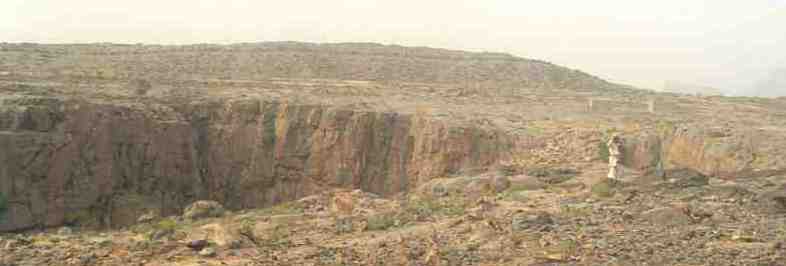
Return to the Stevens Family
Homepage
Back to the
Caving page
Two Hoti Cave Through-Trips
December 18, 1997,
and December 14, 2000
by Vance Stevens
with guest narrator David Brindle
In this article, the pictures of Hoti entry and exit were taken by Arthur Gregory; pics inside cave are mine, all Dec 2000
Two Hoti Cave adventures ...
There are two Hoti Cave adventure stories recorded here. The one in Times New Roman, no italics, is the one I wrote in 1997, on my first through-trip in Hoti Cave, top to bottom. On that trip I had taken no camera, and for three years longed to return to the cave with one. On my second trip, I took a camera, and had hardly got it back home to Abu Dhabi when a friend wrote from California asking, "Do you know this bloke?" 'This bloke' turned out to be David Brindle, one of my caving companions on the just-completed second trip. David had posted an account of our adventures on a UK caving list, where my California friend, by chance a Brit, had picked it up since he followed the lists from home.
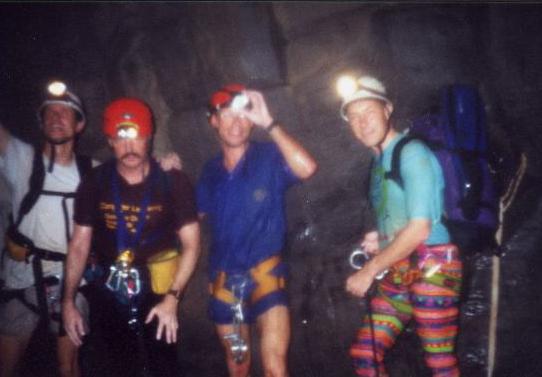 |
David's account of our year 2000 through-trip, forwarded to me by way of my old caving friend in California, is interwoven here in gray Arial italics, like this.
<-- Simon, Vance, David, and Erik mid-Hoti: |
We begin in 1997 ...
Cemal tried to kill me a number of times toward the end of our residence in Oman. He set up my first ever abseil adventure into MajlisAl Jinn, a 178 meter drop which I naively enjoyed at the time. On my next abseil adventure, a mere 100 meters or so vertical drop into Funnel Cave, I got hung up and barely got myself down, leaving kit on the rope which fowled Erik on his descent, though we all survived it somehow. So I eagerly took Cemal up on it when he suggested a relatively non-lethal jaunt through Hoti Cave (unless of course it had rained, which it had been doing the past two months, but we may hit it lucky, Cemal said - I'm easily talked into such trips).
On the appointed day, a Wednesday after work, I bundled my family in the car for the drive back down to Oman (they hadn't packed, they didn't think I'd go with the clouds as threatening as they were). We got off to such a late start that our last-chance dinner was in Al Ain, still in the Emirates. We chose the Hilton and regretted it half an hour into the long wait for our food to be served. We crossed the border late at night (two sets of cards to fill out at the UAE and Omani checkpoints, 4 passports, the scrutiny and eventually the stamps) and an hour later got hung up at a serious midnight Omani roadblock halfway to Ibri. The police wielding flashlights checked all the bags in the front seat but left my family alone and let us pass with a cursory check of our camping gear. By the time we cruised through Ibri everyone was asleep in the car but me. I listened to BBC in English, the midnight to 1 news hour, which took me almost to Bahla. We rolled up at the Hoti cave resurgence an hour after that had finished, climbing the last rocky slope in the moonlight in our Blazer. There were several other cars in the camping area and everyone asleep in tents, so we pitched ours as quietly as we could. The family went to bed in the tent and I slept like a log in the car until 6, when Dusty's alarm went off. He'd left it in the car so as not to wake the others in the tent. Ink, Schnuggs!!
| Next morning we coffee'd (the Arabs make it into a verb) and breakfasted (we make it into a verb) and Bobbi and the kids headed in the car to the capital to visit with Marsha and Neal, especially as Adam was around, one of Glenn's old ABA school chums. Meanwhile, Cemal, Erik, Paul, and Bart and I headed off in Erik's car to the cave entrance up the mountain. We parked in the rocks and headed past the goats and friendly, waving villagers down the hill to the wadi bed leading to the upper end of the cave. On this walk down I slipped on a rock and landed on my little finger in such a way that it came out of joint at a 20-30 degree angle upwards. This startled me, but I reflexively pulled it back into position. The joint made a satisfying click as it went back into place. During the rest of the trip, it bothered me, but it didn't become swollen or painful until days later. |  |
David Brindle's story, December 2000
At last someone else in the real world. Switch off your phones and read on. Along with the Majlis al Jhinn cave with its' incredible 160m pitch, the other classic caving trip in Oman is the Hoti Cave through trip. This is a 4km sporting through trip from sink to rising, with a height difference of about 800m. Simon, Mark and myself travelled from Muscat to meet up with Erik and Vance from Abu Dhabi, and Greg from Saudi Arabia who had driven 15 hours to join this trip. The through trip was surveyed by Waltham et al in 1985 but is rarely done these days - it's extremely arduous. Erik and Vance had done the trip about three years ago. It's as deep as four Penyghent Pots on top of each other, though a lot of the cave descends steadily so there's aren't many pitches. It took us eleven hours, and I'm pretty fit!
| The sink is at the end of a massive blind dry gorge about 100m
deep and 50m wide, and the cave passage doesn't disappoint - it's about 20m
wide and 10m high! The floor is covered with car size boulders, and it's
strenuous work scrambling over, around, and under them. A short pitch just
inside the entrance conveniently keeps tourists from wandering in. It's very
warm in the upper dry parts of the cave, so here we were wearing T shirts and
shorts. After a couple of hours of sweaty progress, Cairn Hall is reached about a kilometre in. This huge chamber is full of hundreds of bats; you can see them whirling about just above your head. David nearing the bottom of the first pitch at the cave entry. Look how clean everybody is! That's Erik on our left, and Simon on the right. |
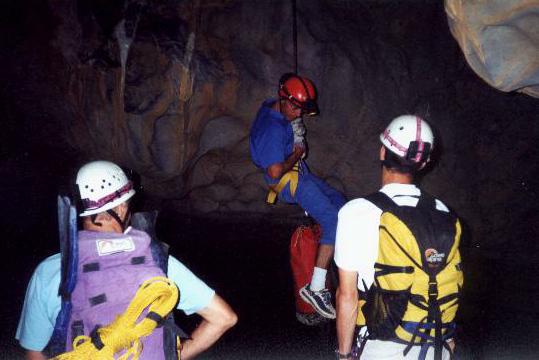 |
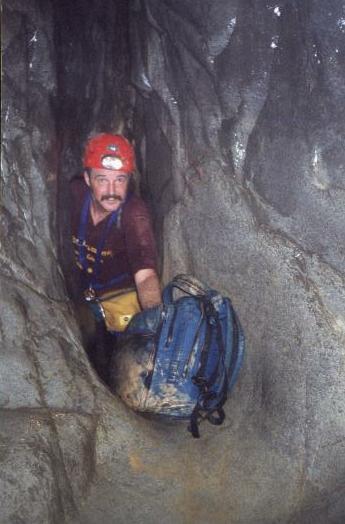 |
We walked into the mouth of the cave to
the first 10 meter pitch where we rigged a rope and descended, leaving the rope
behind to be retrieved later. We intended, in case I haven't mentioned it, to
go through the cave 4 km to its resurgence near our camping spot where Cemal's
wife Nita and Paul's wife Elvira would catch up on their reading during the day
and hone their camp cooking skills that evening in anticipation of our
emergence from the cave. However, in the event the rains had raised the water
level in the cave to the point where we couldn't make it through the sump near
the end, we would have to turn back and climb the pitches we were about to
descend; hence the consideration for leaving ropes in place against that
eventuality. I'm blocking the view, but below and behind me in the hole is one of our first pools of water, which I'm about to slither into. We're just a couple hours into the boulders at this point. |
The cave was superb, one of the best I have ever explored. It wasn't great for decorations, just a few curtains and the usual stalactites and mites. But it was spacious and comfortable (as opposed to cramped California crawlways). I had come prepared to be wet and cold most of the day, but it turned out to be a warm and humid cave, with the water a pleasantly cool, welcome relief against the sweat buildup from carrying a pack that would fill with water through the zippers and not release the water through its waterproofing (must get a suitable pack next time).
| A couple of short static lakes follow that have to be swum;
very refreshing and a taste of things to come. After another kilometre the
passage changes to smaller rift passage only 5 m wide and a stream
enters. Here, David is swimming through an area of giant mushrooms. He has become suddenly small possibly as a result of sampling of one of the 'shrooms. |
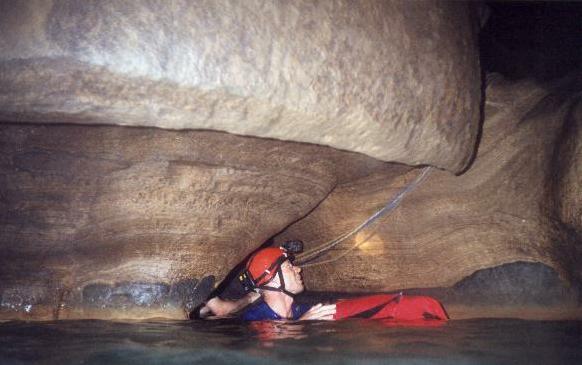 |
The first kilometer was a treacherous slog over devilishly placed boulders, but after a few hours of that, we reached a part where we abseiled down pitch after pitch in subterranean waterfalls, and this was truly beautiful, the trickly water music lending an apropos backdrop to the Styx-like ambience. Though wet was the order of the day, the flowing water eased the friction of ropes passing through figure 8's. Here the cave was like a calcite cathedral, with high vaulted ceilings marking the fault line.
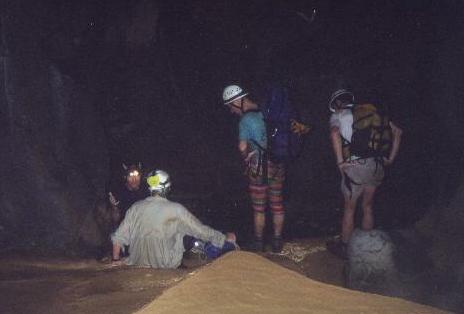 |
Here comes a few pitches, following a series of cascades, and
each pitch lands in a large deep pool, so you just abseil off the rope into the
water and swim to the far side. One pitch even starts directly from the lip of
the previous pool. It's not easy getting a rack on or off the rope underwater
while treading water at the same time! That's Mark, Arthur, Erik, and Simon, left to right. We all thought Erik's pants were a bit of an embarrassment but were too polite to say anything (fortunately, on the web, social norms are not so constrictive!) |
| We passed through chamber after chamber, sometimes walking, and sometimes breast stroking through pools to arrive directly at the next pitch, with some of us waiting in the water while others crawled out on a lip to abseil 10 meters over the edge. | 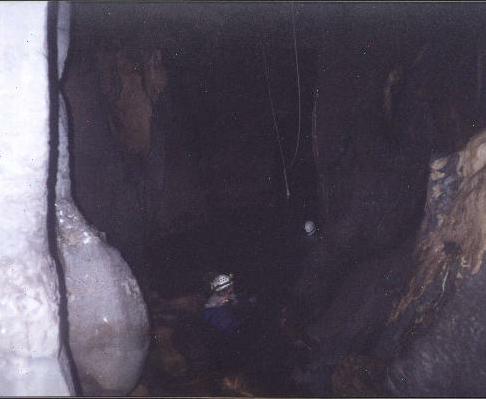 |
 |
It's a through trip, but a 'pull through' would cut off your retreat if you had an accident, so we single rigged with 9mm rope and just abandoned it. Some pitches had several old slings as witness to previous trips. |
| Above, Erik rigs the pitch and, here, goes down first himself while David imagines himself very large above a forest of microscopic mushrooms. | 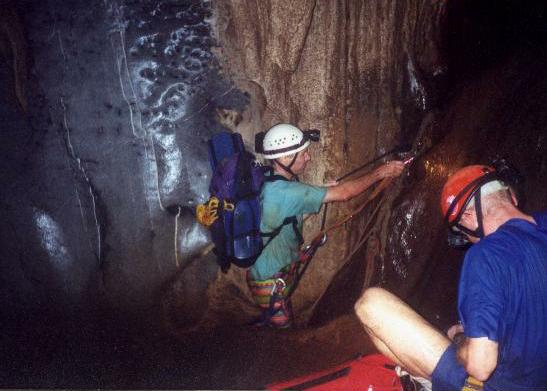 |
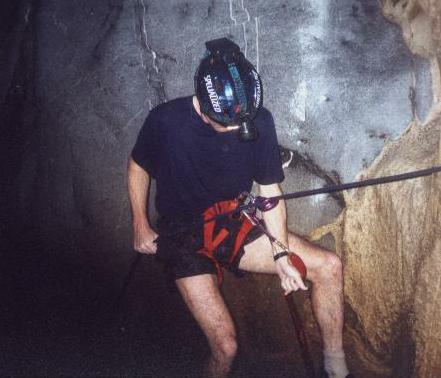 |
Mark prepares to tackle the same ten meter drop down a flowstone into a pool in the dark below. |
After some hours of this we
emerged into an area of goar pools reminiscent of Pamukale in Turkey. Here the
walk was not only watery beautiful, but the sandpaper consistency of the
mineral rock gave us our only sure footing the entire trip. This took us after
another hour to the edge of the final lake, which we would traverse in a
kilometer-long swim to the last half hour hike leading to the exit.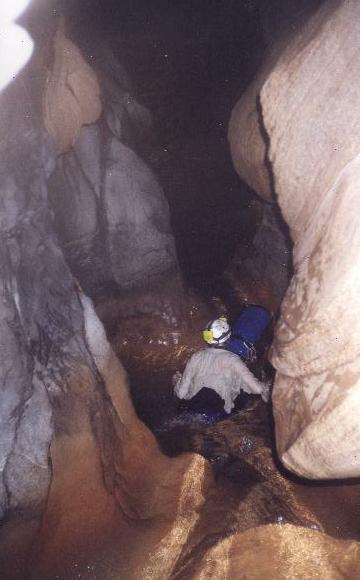 After the pitches comes a long series of lakes, you have to swim across each one towing your tacklebag (you keep your empty water bottles cos they help the bag to float!) but these are just to prepare you for the toughest bit - the big canal. It's about a kilometre and a half long, with nowhere to stand up or get out of the water. Mark and Arthur enjoy the water, refreshingly cool and ever-present at this point in the trip. |
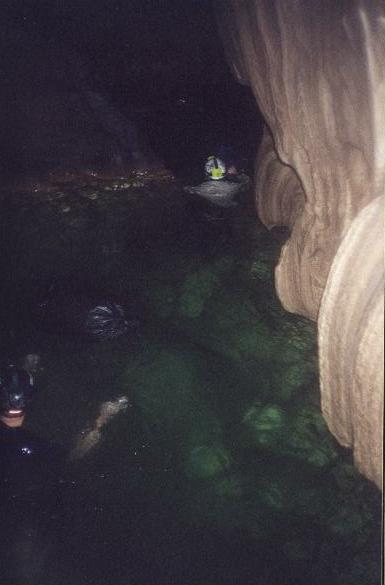 |
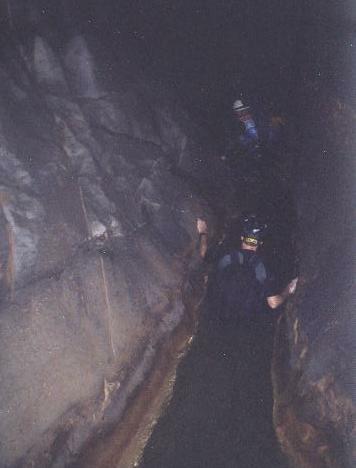 |
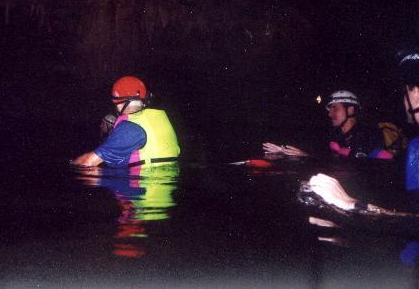 |
Here we rested and ate what we had in our
packs, and changed into our wetsuits and back into flippers. Then we slipped
over a waterfall and into the lake and floated comfortably downstream. All of
us had brought flotation devices. I used an old-style bib stab jacket, but Bart
had brought an inflatable crocodile. I wish I had had a camera. I found out
later I did have a camera. I thought Bobbi had taken it off with her in the
car, but I found it among my things later at the campsite. It was a Minolta
good in water to 3 meters. It would have been ideal for this trip. On the second trip, I took the camera! |
|
We stopped first to eat some food and get our strength up. We put on wetsuits and lifejackets to swim it because you're in the water for an hour and it's quite cold. |
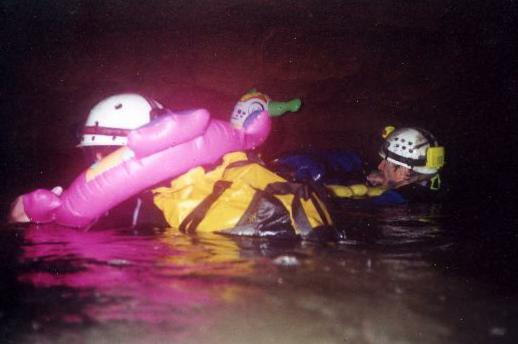 |
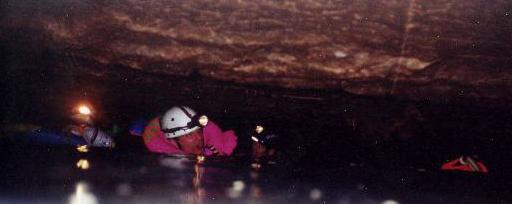
We floated to the one critical spot in our journey. The water sumps at this end of the cave, and there are two places where passage could be impossible, necessitating a return journey. At this point, we were not exhausted by our exertions, but we could see that a retrace of our journey that night, before our batteries ran out, would have led us to that state. Pushing on, at one point we had to float 20 meters with only our noses between the water and the low ceiling. Paul, who knew the way, went first and called back that the passage was doable. Cemal, who doesn't swim, went next, to get it over with. The rest of us followed, kissing rock the whole way.
|
It's all amazing big passage, except at one point where the roof comes down to leave only 10 cm airspace for 30m or so. You swim this slowly on your back, and Simon had a bit of a panic when he veered away from the correct route and found himself pinned under the ceiling with only the tiniest airspace! Simon in a bit of a panic! -->You wouldn't want even a slight rise in water level at this point from a rainshower over the mountains. |
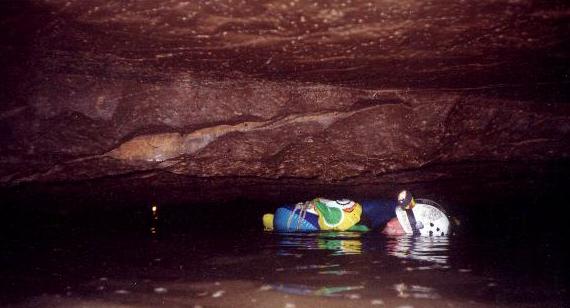 |
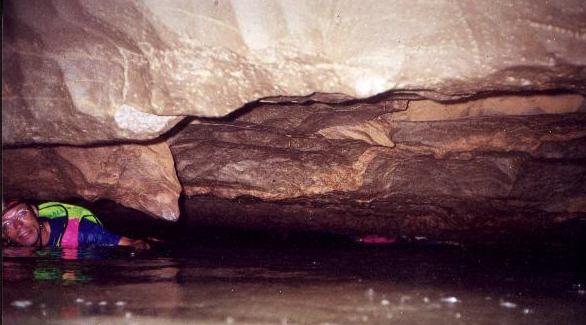 |
Then just before the end of the canal comes the last hurdle - the roof comes right down to make a short sump that you have to free dive. It's only about half a metre long, but by now you're getting tired and cold from swimming so it's pretty frightening. There's still nowhere to stand; you just swim up to it and feel under the roof and pull yourself through. Another 200m swimming and the canal mercifully ends, and more massive dry passage leads easily to the lower exit. The lower exit resembles an enormous Dow Cave entrance. Twenty minutes' walk and we were back at the cars, and the beers from the coolbox never tasted so good. - David Brindle Oman <-- Dave in the cave |
This took us to the final hurdle, an inverted hurdle actually, where we had to go through a submerged hole to reach the chamber opposite. Shining our torches into the hole we could see light on the other side through perforations in the rock wall, so all we went for it. Not much choice, really, drowning, or a long slog back. We all opted for drowning and emerged sputtering on the other side.
We had by then reached a point where I had been before on numerous trips into the resurgence with friends and family when I lived in Oman. From here it was a short swim to the point where there used to be inner tubes from previous cave trips (the tubes had gone, unfortunately; we tried to get Bart to leave his crocodile, but he had become attached to it, and could not part with it, and wished to blow it up later in the privacy of his tent and further consort with it). And so we walked out of the cave and into the campsite below where awaited hot pasta dishes and beer.
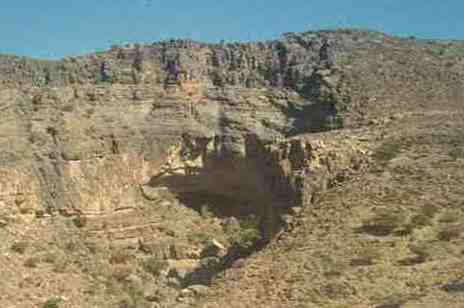
Thanks, Greg, for the use of your pictures!
Next day, we went back for the rope we'd left at the first pitch. Some village boys followed us down to the cave asking where the others were. They had seen 5 go in, and now we were 3. I tried to explain that the cave came out the other side.
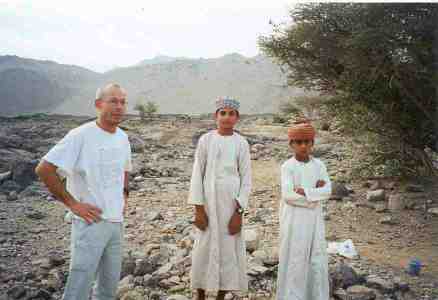
Later that day we drove over to Misfah to visit the village and look at another cave in the area, a sinkhole which we heard had foul air below. We found the hole and followed the road to a village at its end where we sat down to coffee and dates with the villagers. I asked the villagers if there were any more caves in the area, and they told me of one called Nahr above Wejmah, which we could best reach from that village in 5 hours. As we were leaving, our host expressed regret that we had not come on a Thursday. If we could come back on a Thursday he said, they could send someone with us to show us the cave. As it was Friday, he said, it would be inconvenient to go there just then, as we'd arrive at 6 in the evening. We had never asked for a guide to the cave, but he out of the blue offered one, but only if we would return on a Thursday. Amazing people, to offer strangers a guide who would go 10 hours out of his way to show us a cave we had only then learned about.
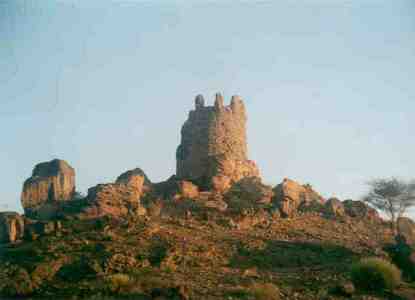
After that we visited Misfah, a charming village above Al Hamra and at the base of trails leading into the Jebel to all the wadis on the other side. At a time before the road, not so many years ago, Misfah would have been accessible only by hiking or by donkey. Now it was visited daily by tourists, not all of whom could understand its unique position. Misfah sits above a high wadi full of date palms, from which it must derive its wealth. Its houses are built like an Italian village into the hillside, complete with archways over its stone passages, and an ancient watchtower. It blends well with its surroundings, from which it extracts water in a picturesque falaj leading through a pool set above the terraces and full of happy kids on hot summer mornings.
After a hot walk down from where Don Carroll and I had slept at the top of the jebel at one point during my residence in Oman, we had wound up in Misfah in the early afternoon. The friendly villagers had sent for a daughter to open the store by the town gate so that Don and I could slake our thirst on soda pop. There are always a couple of old men sitting there, and we fell into conversation with them. Meanwhile, a couple of tourists rolled up and walked self-consciously through the gate, looking and no doubt feeling out of place, no knowledge of Arabic, nor of local sensitivities. This is a town that used to be on the tour bus route until the villagers put a stop to these most egregious of incursions. One of the old men indicated the tourists passing and said something to the effect of: typical, no salaam wa alaikum, they just come and walk around, and don't say anything to anyone. The villagers of Misfah respond warmly if you say hello and can't and don't want to understand the camera toting tourists who don't.
On this trip to Misfah I wandered around with Paul and Elvira, Bart and Erik. Erik eventually wandered off and after a time I went looking for him. When I returned to where I'd left the others, they were gone. I went looking for them in the upper parts of the town where it was difficult to distinguish public walkway from private foyer, and I inadvertently walked in on a family gathering in an alcove. I tried to escape my faux pas, but the family called me back and insisted I redeem myself by sitting down to tea with them. So I sat with a lady presiding with a tea kettle over a brood of sons, daughters and grandchildren. They poured me a tea and sent out for oranges. In the lull while we were waiting for the food, I said I needed to leave and find my friends, so they took me to a window overlooking the town center, and there was Erik sitting down there, waiting for the rest of us. So I excused myself to join him and barely got away with a couple of oranges stuffed in my hands on exit. The Omanis are remarkably wonderful people, lucky enough to live in a remarkable land.
Viewed since Dec. 20, 2000:
Use your browser's BACK button to return to a previous page
For comments, suggestions, or further information on this page, contact Vance Stevens, page author and webmaster.